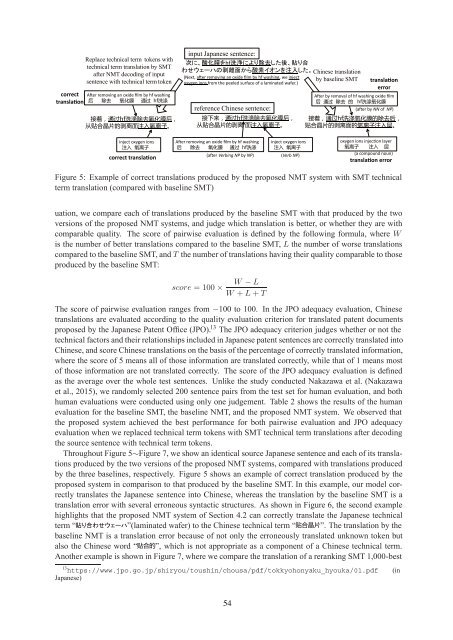December 11-16 2016 Osaka Japan
W16-46
W16-46
Create successful ePaper yourself
Turn your PDF publications into a flip-book with our unique Google optimized e-Paper software.
Figure 5: Example of correct translations produced by the proposed NMT system with SMT technical<br />
term translation (compared with baseline SMT)<br />
uation, we compare each of translations produced by the baseline SMT with that produced by the two<br />
versions of the proposed NMT systems, and judge which translation is better, or whether they are with<br />
comparable quality. The score of pairwise evaluation is defined by the following formula, where W<br />
is the number of better translations compared to the baseline SMT, L the number of worse translations<br />
compared to the baseline SMT, and T the number of translations having their quality comparable to those<br />
produced by the baseline SMT:<br />
score = 100 ×<br />
W − L<br />
W + L + T<br />
The score of pairwise evaluation ranges from −100 to 100. In the JPO adequacy evaluation, Chinese<br />
translations are evaluated according to the quality evaluation criterion for translated patent documents<br />
proposed by the <strong>Japan</strong>ese Patent Office (JPO). 13 The JPO adequacy criterion judges whether or not the<br />
technical factors and their relationships included in <strong>Japan</strong>ese patent sentences are correctly translated into<br />
Chinese, and score Chinese translations on the basis of the percentage of correctly translated information,<br />
where the score of 5 means all of those information are translated correctly, while that of 1 means most<br />
of those information are not translated correctly. The score of the JPO adequacy evaluation is defined<br />
as the average over the whole test sentences. Unlike the study conducted Nakazawa et al. (Nakazawa<br />
et al., 2015), we randomly selected 200 sentence pairs from the test set for human evaluation, and both<br />
human evaluations were conducted using only one judgement. Table 2 shows the results of the human<br />
evaluation for the baseline SMT, the baseline NMT, and the proposed NMT system. We observed that<br />
the proposed system achieved the best performance for both pairwise evaluation and JPO adequacy<br />
evaluation when we replaced technical term tokens with SMT technical term translations after decoding<br />
the source sentence with technical term tokens.<br />
Throughout Figure 5∼Figure 7, we show an identical source <strong>Japan</strong>ese sentence and each of its translations<br />
produced by the two versions of the proposed NMT systems, compared with translations produced<br />
by the three baselines, respectively. Figure 5 shows an example of correct translation produced by the<br />
proposed system in comparison to that produced by the baseline SMT. In this example, our model correctly<br />
translates the <strong>Japan</strong>ese sentence into Chinese, whereas the translation by the baseline SMT is a<br />
translation error with several erroneous syntactic structures. As shown in Figure 6, the second example<br />
highlights that the proposed NMT system of Section 4.2 can correctly translate the <strong>Japan</strong>ese technical<br />
term “ ”(laminated wafer) to the Chinese technical term “ ”. The translation by the<br />
baseline NMT is a translation error because of not only the erroneously translated unknown token but<br />
also the Chinese word “ ”, which is not appropriate as a component of a Chinese technical term.<br />
Another example is shown in Figure 7, where we compare the translation of a reranking SMT 1,000-best<br />
13 https://www.jpo.go.jp/shiryou/toushin/chousa/pdf/tokkyohonyaku_hyouka/01.pdf (in<br />
<strong>Japan</strong>ese)<br />
54



